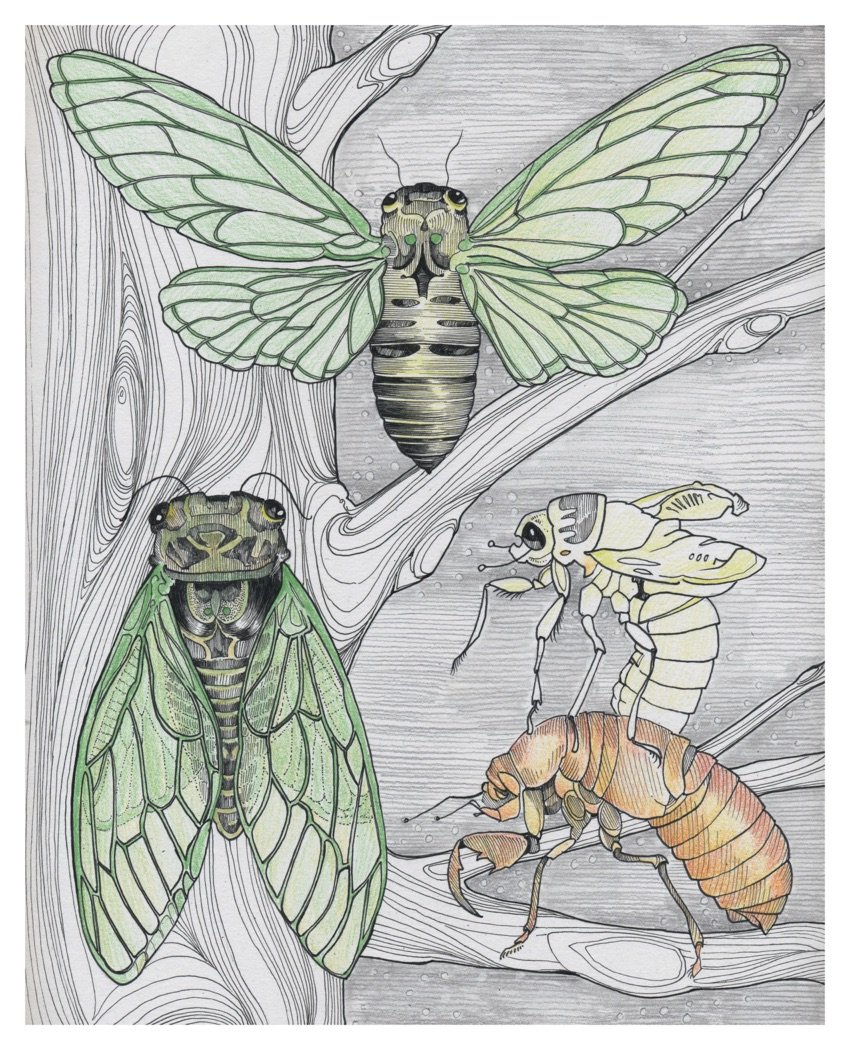 Image 1 of
Image 1 of


CICADAS 8" x 10" print
“Science asks us to learn about organisms. Traditional knowledge asks us to learn from them”. -Robin Wall Kimmerer
This artwork is from a 2022 wall calendar project and is exploring how change happens in the more-than-human world. What is the pace? What is the scale? The catalysts, the intelligence, the resources? The plants and animals are powerful teachers and offer abundant examples of how, specifically, to practice a cooperative, interconnected life. Here I explore examples of Pollination (sharing), Metamorphosis (forming), Germination (growing), and Decomposition (Dying). Each monthly page includes a few questions about how these examples might translate to human experiences.
Metamorphosis: RE-FORMING. CICADA. These creatures have a total life span of 13-17 years and live underground for most of it. By emerging all at once, in large densities of up to one and a half million per acre, cicadas manage to overwhelm predators who quickly get too full. In this particular transformation, the pace and scale of change ensures a high survival rate for the species. When looking at different systems in our world, when have you noticed change happening slowly over time? When have you seen a huge shift happen all at once?
“Science asks us to learn about organisms. Traditional knowledge asks us to learn from them”. -Robin Wall Kimmerer
This artwork is from a 2022 wall calendar project and is exploring how change happens in the more-than-human world. What is the pace? What is the scale? The catalysts, the intelligence, the resources? The plants and animals are powerful teachers and offer abundant examples of how, specifically, to practice a cooperative, interconnected life. Here I explore examples of Pollination (sharing), Metamorphosis (forming), Germination (growing), and Decomposition (Dying). Each monthly page includes a few questions about how these examples might translate to human experiences.
Metamorphosis: RE-FORMING. CICADA. These creatures have a total life span of 13-17 years and live underground for most of it. By emerging all at once, in large densities of up to one and a half million per acre, cicadas manage to overwhelm predators who quickly get too full. In this particular transformation, the pace and scale of change ensures a high survival rate for the species. When looking at different systems in our world, when have you noticed change happening slowly over time? When have you seen a huge shift happen all at once?
“Science asks us to learn about organisms. Traditional knowledge asks us to learn from them”. -Robin Wall Kimmerer
This artwork is from a 2022 wall calendar project and is exploring how change happens in the more-than-human world. What is the pace? What is the scale? The catalysts, the intelligence, the resources? The plants and animals are powerful teachers and offer abundant examples of how, specifically, to practice a cooperative, interconnected life. Here I explore examples of Pollination (sharing), Metamorphosis (forming), Germination (growing), and Decomposition (Dying). Each monthly page includes a few questions about how these examples might translate to human experiences.
Metamorphosis: RE-FORMING. CICADA. These creatures have a total life span of 13-17 years and live underground for most of it. By emerging all at once, in large densities of up to one and a half million per acre, cicadas manage to overwhelm predators who quickly get too full. In this particular transformation, the pace and scale of change ensures a high survival rate for the species. When looking at different systems in our world, when have you noticed change happening slowly over time? When have you seen a huge shift happen all at once?